The Legend of Zelda: Spirit Tracks is a video game released in the year 2009 for the original Nintendo DS. It was

The Legend of Zelda: Spirit Tracks
the sixteenth game released in The Legend of Zelda Franchise.
Bridge Worker[]

Bridge Worker
Shipyard Worker from The Legend of Zelda: Phantom Hourglass and may be a descendant of his. Supporting this theory is a picture of the Shipyard Worker found in the Bridge Worker's house.
Force Gem[]
It is theorized that at the end of The Legend of Zelda: The Minish Cap, the Light Force may have
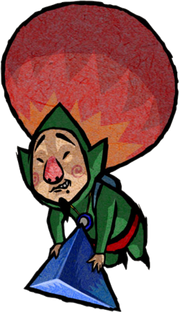
Force Gem
been fragmented into the Force Gems used to power up the Four Sword in Four Swords Adventures. According toHyrule Historia, the Light Force contains a huge amount of the force that dwells in all living beings. This also supported by how it has the same name in Japanese as the Light Force and the Life Force.
It should also be noted however, that Zelda still has at least a portion of the Light Force, which was noted by Ezlo himself. It was also hinted by Ezlo (in the Japanese version) that the amount Zelda has was the reason (along with her kindness) for the miracle the Minish Cap created towards the end. The Light Force is also theorized as the reason for Zelda's natural mystical powers, which is heavily hinted to be hereditary in nature. The Japanese version also stated that the Light Force is a "limitless" thing of "magic" rather than a force of life.
In The Legend of Zelda: Phantom Hourglass, Force Gems are similarly described as a manifestation of life force. As the story in Phantom Hourglass mostly takes place in the World of the Ocean King, that could explain the Force Gem's presence there. It should be noted however, that the Force Gems also appear in Spirit Tracks, which implies it actually is a thing in Link's world (and not just the land of Hyrule) as the game itself took place in New Hyrule. Since Carben stated that a Force Gem can be created when someone feels powerful emotions, this further disproves that the Light Force and Force Gems are the same.
Force Gems also bear some resemblance to the Triforce, as both are triangles and contain the word "force" in their name. However, there is no known connection between them.
Also, if Carben is to be believed that Force Gems appear when a person feels strong gratitude, then it is possible that the Gratitude Crystals in The Legend of Zelda: Skyward Sword might be a variation on them.
Hero's Clothes[]
Because the Link in The Legend of Zelda: Skyward Sword was the first hero chosen by the Gods, and

Hero's Clothes
the knights are seen wearing the Hero's Clothes, it is possible that this is where they originated from, and from this Link they have been passed down. It is more likely however, that the Hero of Time was the one who passed down the idea as shown in Wind Waker and Twilight Princess.
Link[]
Reincarnation[]
A common theory as to why each incarnation of Link looks similar and have similar abilities is that they are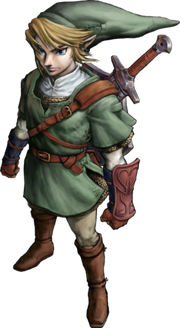
Link
Relatives[]
Another theory as to why each incarnation of Link looks similar to one another is that they are actually related to one another. This is supported by the fact that the Hero of Time is the ancestor of Link in Twilight Princess as well as how it is stated in A Link to the Past that the Master Sword can only be pulled out from its pedestal by the ones who carry the bloodline of the Knights of Hyrule. It is possible that when Demise stated "Those like you... Those who share the blood of the goddess and the spirit of the hero," when he put a curse on Link and Zelda, he was actually referring to the "spirit of the hero" as a form of will or a set of personality traits rather than the soul itself. If this is the case, this could explain each Link's connection with the Triforce as well as their abilities in physical, mystical, and spiritual ways.
This may mean when he was stating "Those who share the blood of the goddess" he was referring to Skyward Sword Link and Zelda's descendants as the other incarnation of Links rather than the Royal Family of Hyrule, where an alternate reason for the Royal Family having magical powers is the Light Force as hinted in The Minish Cap. This would explain why Link faces other adversaries aside from Ganon, with Zelda (or other members of the Royal Family) sometimes not being present to support the side of good in games such as as Majora's Mask, Link's Awakening and Tri Force Heroes The original Japanese text that Demise states is that his hatred and the Demon Tribe will go under an "evolution", which may mean the curse could involve other villains apart from Ganon himself.
If each Link is related to one another, they need not be related along a single line of descendants. For example, the Hero of Winds cannot be a direct descendant of the Hero of Time since the latter returned to the Child Timeline immediately after his victory over Ganon while being a young preteen in a teenager's body, but provided the Hero of Winds can trace his lineage to Skyward Sword Link, the theory still holds. It is possible that the reason why the Master Sword can only be pulled from it's pedestal by someone who carries the bloodline of the Knights of Hyrule is actually a sub-conscience decision by Fi, who is the spirit of the Master Sword.
Madas[]
It is possible that in the contemporary Hylian language during the events of Skyward Sword, Link's name may be "Madas" when pronounced. This would explain why Fi, when talking to Link in dialogue that uses his name, often says "Madi Madas" with "Madi" possibly being "Master" in the language. Alternatively, it is possible that Fi's words are gibberish used repetitively in the game, similar to Midna in Twilight Princess.
Lokomo[]
It is possible that the Lokomos are further reincarnations of the Seven Sagesor Ancient Sages
since there
The Lost Woods[]
The Lost Woods is a recurring location in the Legend of Zelda series. This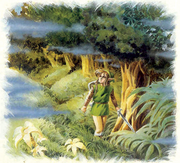
The Lost Woods
The Legend of Zelda: The Wind Waker[]
It is theorized by some that the Lost Woods became the Forbidden Woods. Evidence supporting this theory is that the Lost Woods from Ocarina of Time are near Kokiri Forest, and that the Forbidden Woods from The Wind Waker are near the Forest Haven. The Kokiri Forest and the Forest Haven are theorized to be the same place, since they have similar climates and both are home to the Great Deku Tree. Also, there are stump-shaped houses inside the Forbidden Woods which look very similar to the houses of the Kokiri in the Kokiri Forest from Ocarina of Time, and a Korok tells Link that he may see some of their old houses in the Forbidden Woods.
The Legend of Zelda: Twilight Princess[]
The Sacred Grove in this game is believed by many to be part of the Lost Woods. Though this has never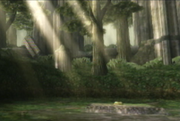
The Sacred Grove
Both areas in each game are high, circular chambers deep in the forest. Also, when Link looks up in the Sacred Grove, he can actually see what appears to be the Forest Temple from Ocarina of Time, which appears as an immense archway. There is also a room with a bomb-able rock hiding an Imp Poe and the entrance to a Dig Cavern which also resembles this area.
Mountain Goddess[]
Some theorize that the Mountain Goddess is Din, one of the three Golden Goddesses. Din is known for creating the earth and its features, which would include mountains and her strong alignment with the element of fire and with the Goron race itself. It is possible that, over time, her name faded out of memory and she came to be referred to as the Mountain Goddess. However, the Mountain Goddess has never been mentioned in any games other than Spirit Tracks, by the Gorons or any other race. Also, the eruptions believed to be caused by the Mountain Goddess were in reality caused by Cragma. This may indicate that the Mountain Goddess may not even be real.
Multiple Ganon Theory[]
The Multiple Ganon Theory is the theory that there exists more than one Ganon/Ganondorf in the Zelda timeline, in much the same way that Link and Princess Zelda exist as more than one person throughout the Legend of Zelda series. Variations include ideas that Ganondorf is locked in the same cycle of reincarnation as Link, or that Ganon is a malevolent demon who possesses people, Ganondorf being one such host. Supporting the reincarnation idea, it is said by the Gerudo that only a single male is born into their tribe every one hundred years. Depending on the game, he is said to be destined to become either the King of the Gerudo or the guardian of the desert and the Gerudo.
Although the theory has been around for quite some time, most modern versions of this theory stem out of Ganondorf's back-story in The Legend of Zelda: Four Swords Adventures, which conflicts with Ganondorf's back-story in The Legend of Zelda: Ocarina of Time. In Four Swords Adventures the Gerudo talk about a man named Ganondorf who had been born and lived in the Desert of Doubt with them. They mentioned that he had grown into an evil man with a lust for power and had broken their laws by stealing a Trident deep in the desert that gave him incredible powers, such as transforming him into Ganon.
This is in direct contrast to the back-story Ganon was given in Ocarina of Time, in which he is acknowledged by many as the king of the Gerudo, and does not become Ganon until acquiring the Triforce of Power. Additionally, the back-story of The Legend of Zelda: Twilight Princess, which explains the actions of the Ganondorf from Ocarina of Time in an alternate timeline, says that a tribe of thieves, most likely the Gerudo, followed him in his attack on Hyrule, again showing that he was accepted as king.
There are only three logical explanations to these conflicting back-stories:
One is that a single Ganondorf had ventured to the desert and stolen the Trident, broke out of the seal he was placed at at the end of Four Swords Adventures but was not killed by Link, turned back into Ganondorf, and returned to the Gerudo later at a time that they were willing to acknowledge him as king. This would require that Four Swords Adventures take place before Ocarina of Time. The second explanation is that the game is not part of the overall storyline within the series, though official statements indicate that all the games from the main series are included in the official timeline document. The third explanation is that the Ganondorfs from the two games are separate incarnations, much like the many Links, Zeldas, and other characters who are seen multiple times throughout the series. This theory is supported by a quote at the end of Four Swords Adventures in which Princess Zelda calls Ganon an "ancient demon reborn". This is similar language to a line in The Legend of Zelda: The Wind Waker in which Ganondorf calls the game's incarnation of Link "The Hero of Time, reborn". Another solid point for this theory is the apparent death of Ganondorf/Ganon five separate times throughout the series. An individual Ganon is only shown to be resurrected once. Even with this resurrection, and the split timeline allowing a single individual Ganon to die twice, there would still need to be three separate Ganons in order to account for all of the presumed deaths. In order for all of the Ganons in the series to be the same, Ganon would have to have been brought back to life on two additional occasions not hinted at by any of the games, or survived at least two of his apparent deaths.
In The Legend of Zelda: Skyward Sword, Demise states that his hatred will be reincarnated and attack in a cycle without end. This is often interpreted as meaning that Ganon's repeated appearances are a result of this cycle. If Ganon as we know him is a result of Demise's hatred continuously reincarnating itself, there would be further support for the idea that multiple Ganons could continue to appear even as previous ones are slain. This would support the Multiple Ganon Theory as each Ganon would be a separate incarnation in this cycle, though all of them would share the same basic origin of forming from Demise's hatred.
While the Multiple Ganon Theory has yet to gain wide spread acceptance, it has nonetheless gained the respect of some timeline theorist and fans of the series.
Shigeru Miyamoto has stated that although each Link and Zelda are reincarnations, there is "only one Ganon". However, this statement may now be outdated or may have been made based on a lack of information, as Miyamoto is no longer as involved with the Zelda storyline as he previously was.
According to the Hyrule Historia, a second Ganondorf is born during the events leading to Four Swords Adventures. The book either implies or states directly that the rest of Ganon's appearances are the same being brought back to life, or versions of him in alternate timelines.
Niko[]
Some fans speculate that Niko could possibly be descended from the Royal Family of Hyrule. He is a close friend of Tetra, a proven descendant of Princess Zelda. He also closely resembles a man from a painting of the Royal Family, found in Hyrule Castle in The Wind Waker. Also, many of the other members of the Royal Family resemble other members of Tetra's Pirates, and both groups include seven members each. It is possible that at the time of the Great Flood, everything that the Royal Family had was destroyed. Having nowhere to go, they may have built a ship and became pirates.
Postman[]
It is heavily implied that a member of the Rito tribe in The Wind Waker, Koboli, is a
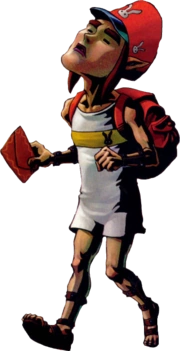
descendant of either the Running Man of Ocarina of Time or the Postman of Majora's Mask. This is due to the obvious similarities in facial appearance. Koboli's occupation also suggests that he is a descendent of the Postman; the text from the Nintendo Gallery explicitly states that he belongs to a family that has been of the mailing profession for generations.
Princess Zelda[]
The relationship Zelda has with Link is close, possibly her closest. A popular theory among
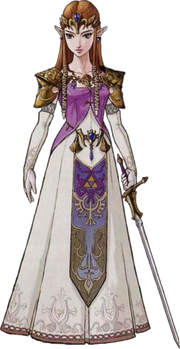
fans is that of a romantic relationship between some of the Zelda and Link characters in the Zelda series. Although never explicitly confirmed in a video game title, this theory is based on hints given in the games, interviews with the game creators, and content of the animated series, comics, and manga (although the last three are generally considered non-canonical).
One hint of a romance between Zelda and Link is given at the end of The Adventure of Link, when the awakened Princess apparently kisses Link under the falling curtain.
Some cutscenes in Ocarina of Time featuring the two together have been interpreted as signs of an attraction. While Link and Zelda are escaping Ganon's Castle, Zelda will additionally show her concern for Link by shouting out whenever he is hurt. Moreover, in the game's final scene, Zelda and Link are floating in the sky together, sharing a decidedly sentimental (if not necessarily romantic) moment where Zelda apologies for involving Link in the events of the game and seems saddened by the situation. She also stated that she will not forget the time she spent with him in the Child Timeline as shown in Majora's Mask through Link's memory.
In addition, if the Oracle games are played as sequels to each other, the ultimate ending sequence shows Zelda lightly kissing Link on the cheek. Link swoons while hearts float above the pair's heads, and Zelda looks away, blushing. In The Wind Waker, when Zelda is asked to stay in hiding in Hyrule Castle while Link restores power to the Master Sword, she waves goodbye to Link, asking him to be careful.
Spirit Tracks features several moments that can be interpreted romantically. Early in the game
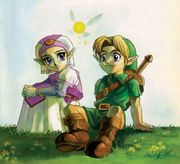
during the Graduation Ceremony, Zelda walks into the room in front of Link, who is bowing down respectfully. Link then looks up and gasps, blushing at her in amazement. He is then scolded by Chancellor Cole for raising his head without permission. Later, when Zelda's spirit is separated from her body following the first encounter with Chancellor Cole and Byrne, Link is the only one who can see her besides the Lokomos, demonstrating a clear and strong bond between himself and the Princess. After Zelda and Link defeat Byrne in the Tower of Spirits, Byrne, disbelieving, comments that he was beaten by two humans. Zelda, while still possessing a Phantom, says that when she and Link combine their strength, no one can defeat them. Link turns to her, surprised. The background turns white and Zelda's Lullaby plays as they both laugh and high-five, gazing at each other all the while. Toward the end of the game, before the final battle against Malladus, Zelda is reunited with her body, and is no longer able to levitate. Link runs underneath her to catch her as she falls, and she lands on top of him and knocks them both to the ground as well as knock Link out for a few seconds. Upon awakening, Zelda, overjoyed to have her body back, embraces Link, causing him to blush. Finally, after Malladus is defeated, Zelda and Link watch Anjean and Byrne's spirits ascend to the heavens. The camera then lowers to show Zelda and Link holding hands while Zelda's Lullaby plays in the background. After the credits, a short cut scene shows Zelda gazing at a picture of Link on the Spirit Train with her flying beside him, which she keeps on her desk. she may also wave at Link depending on his answer to a question Zelda asked before.
Skyward Sword has several noticeable romantic moments between Link and Zelda. Early in the game, Zelda wants Link to be the first to see her outfit for the Wing Ceremony. She worries over him and she does not want him to fail at becoming a knight. When Link's Crimson Loftwing is hidden by Groose, Zelda assists Link in finding his Loftwing. After Link wins the Wing Ceremony, Zelda jumps off the ledge and Link catches her almost as if she was expecting him to. She then congratulates him on winning. Afterwards, Zelda mentions that she is very happy to be atop the Statue of the Goddess with him. She also gets extremely close to him and almost implies that the two are to kiss, before she pushes him off the statue. Afterward, Zelda bashfully asks Link to go out flying which they do. She then tells Link how amazing the day was, and that she would remember it forever. At the Temple of Hylia, when Zelda states she must seal herself to keep Demise in place, she sheds tears of sadness and states before all this, she was happy just being with Link on Skyloft, demonstrating a deep level of feelings for Link. Link desperately tries to stop her and when she is sealed, Link lowers his head in sadness, showing his deep feelings for her. Much later in the game, when Link releases Zelda from her sealed state, Link runs up and catches her from falling and both of them hug and walk out smiling at each other, holding hands, before Ghirahim ruins the tender moment. During the ending, Zelda asks what Link will do now. Link sweetly smiles at her while their Loftwings fly off toward the sky, implying that he chose to stay on the Surface to live with Zelda.
A Link Between Worlds features some gossip told to Link by the Rumor Guy. He tells Link that one of the castle staff had seen Zelda sneaking off every night. When she followed her, she saw Zelda staring at the painting in Hyrule Castle depicting the Link and Zelda from A Link to the Past cuddling with each other, implying they became more intimate with each other. This also hints the Zelda in A Link Between Worlds wants to have a similar relationship with the Link of her time.
The game creators also seem to be fond of the idea of romance between the characters.[1]
Though never directly stated in-game, Shigeru Miyamoto revealed in an interview conducted by Famimaga 64 that Navi is jealous of Princess Zelda and has feelings for Link.[2]
Another less popular theory among fans is that Link and Zelda are related by blood, either as siblings or more distantly. Even though rumors to this effect started with the infamous "Save the Princess... Zelda is your... ... ..." line from A Link to the Past (later reported as a mistranslation), the theory generally revolves around the Link and Zelda from Ocarina of Time.
A possible indication of a blood relation between the two in Ocarina of Time is their physical resemblance: they both have blonde hair, blue eyes, and similar facial features. They also have similarly shaped heads. Graphics limitations could be responsible for some of this similarity, however. Certain dialogue could also be perceived as implying a blood relation: the ghost Sharp comments that Link reminds him of Zelda, and that Link "may have some connection with the Royal Family".[3] Link's connection to the Royal Family is highlighted throughout the game, with Link often playing Zelda's Lullaby to verify it. The fact that Impa agrees to teach a strange boy a song only Royal Family members are allowed to know could also be interpreted as a hint at Link's blood relation to Hyrule's Royal Family. [4]
Additionally, Zelda seems to recognize Link's name upon their first meeting.[5] This could be attributed to her prophetic abilities, although the boy in her dreams seemed to be a largely abstract figure, with no defining traits aside from the presence of a guardian Fairy and a Spiritual Stone. This line of dialogue has often been regarded as a sign that the two have met before, although this could only have occurred when Link was a baby per the Deku Tree Sprout's account of Link's coming to Kokiri Forest. It is also worth noting that while the King of Hyrule is clearly identified as Zelda's father, no mention is made of a Queen. Meanwhile, Link's mother is stated to have died shortly after reaching the forest, but no information is given concerning his father. Given these facts, it is possible that Zelda and Link share the same parents, making them siblings.
Sacred Power of the Spirits[]
In The Legend of Zelda: Phantom Hourglass, it was stated that Tetra had the Light Force inside her, presumably passed down to Zelda. This hints that the Sacred Power of the Spirits is actually the Light Force. This is backed up in The Legend of Zelda: The Minish Cap, where it was stated that the Light Force is passed down to generations of The Royal Family of Hyrule and hinted to be the source of Zelda's natural power.
An alternative explanation could be how in The Legend of Zelda: Skyward Sword, it is revealed that Zelda was reincarnated from the goddess Hylia. Therefore, the Sacred Power of the Spirits may be connected to Hylia's power. There is no solid evidence that states Skyward Sword Zelda is the ancestor of the Royal Family of Hyrule, however.
Split Timeline[]
It is speculated by some that alternate worlds such as the Twilight Realm and Termina may be unaffected by the timeline split. However, while these two realms are alternate dimensions, there is no evidence to support the idea that they exist outside of linear time. Both realms have demonstrated the ability to receive beings from the Child Timeline and return them to the Child Timeline when they exit back into Hyrule. There is no reason to believe that these two realms would only exist as a single timeline, or that they could "prioritize" inputs from one timeline, and later output these into both the timelines.
In addition, the renowned Youtube show, Game Theory, dismissed the Zelda Timeline, particularly the Defeat Timeline (in where Link fails on his quest) on the grounds that "the hero cannot be simultaneously victorious and defeated". Elaborating, he explained that with Link defeating Gannondorf, two perfectly possible timelines are created; However if Link dies at any point in his journey another separate timeline is created. Explaining that the only way for all 3 timelines to exist is the Many Worlds Theory (the theory that all possible pasts and futures exist in separate timelines).
Star Fragments[]
Star Fragments share a similar name and appearance with Star Bits from Super Mario Galaxy and

Super Mario Galaxy 2, and may have been inspired by them.
They are also possible inspirations to Gratitude Crystals from The Legend of Zelda: Skyward Sword.
Take 'Em All On Proprietor[]
The Take 'Em All On Proprietor bears a striking resemblance to Jolene, a pirate from The Legend

of Zelda: Phantom Hourglass, and may be her descendant.
Tingle[]
A character named Purlo appears in The Legend of Zelda: Twilight Princess. Purlo is possibly a
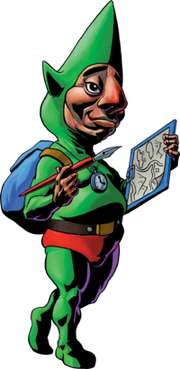
reference to what Tingle would look like if he was a more realistic character. Purlo is the manager of the STAR Game in Hyrule Castle Town, and he wears a similar costume to Tingle. He is also obsessed with Rupees, much like Tingle. Unlike Tingle though, Purlo has an unfriendly attitude towards others.
